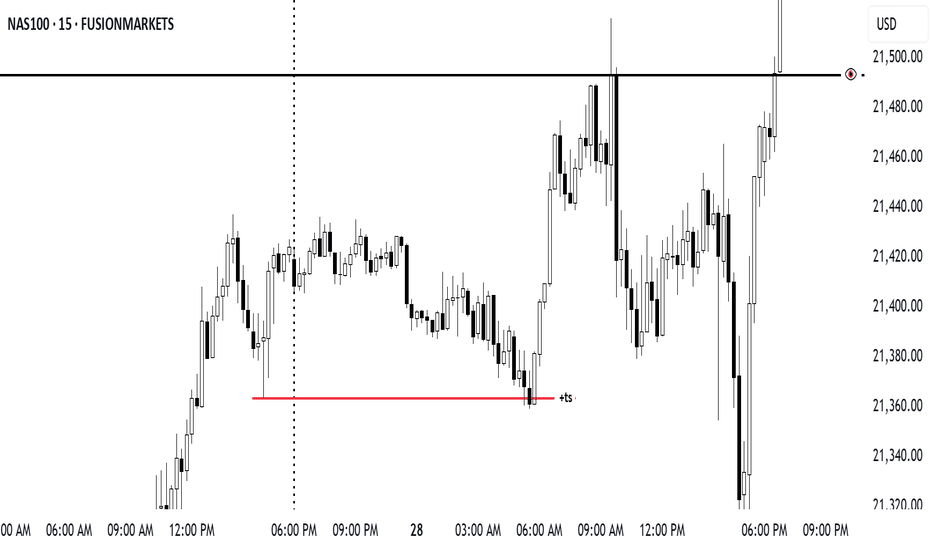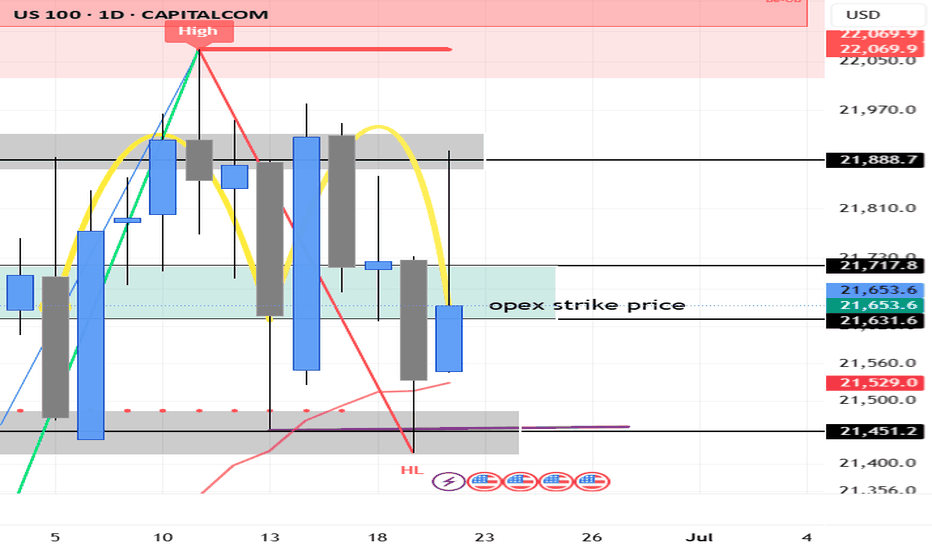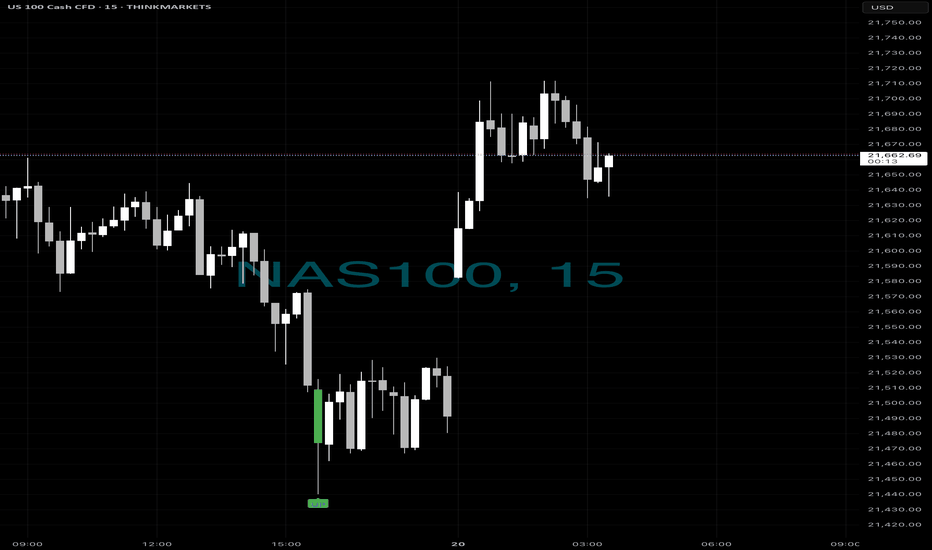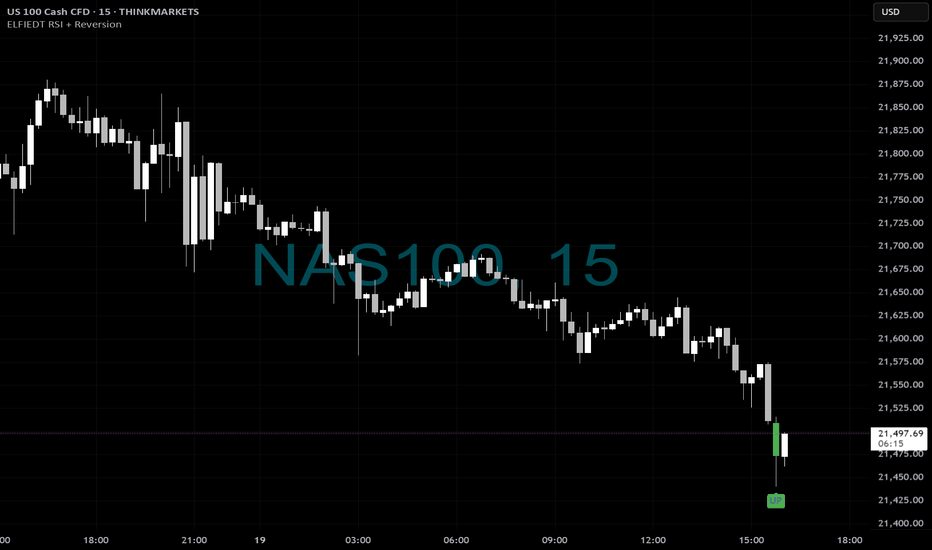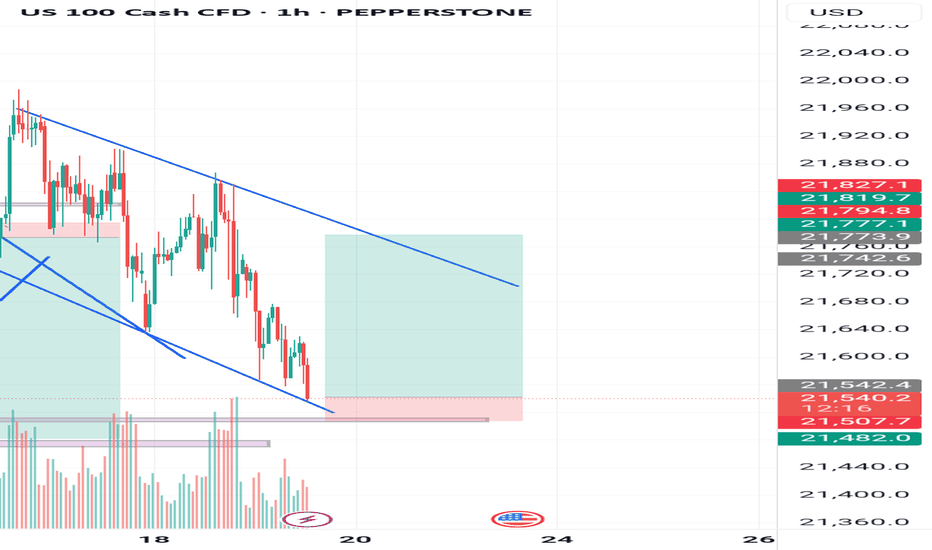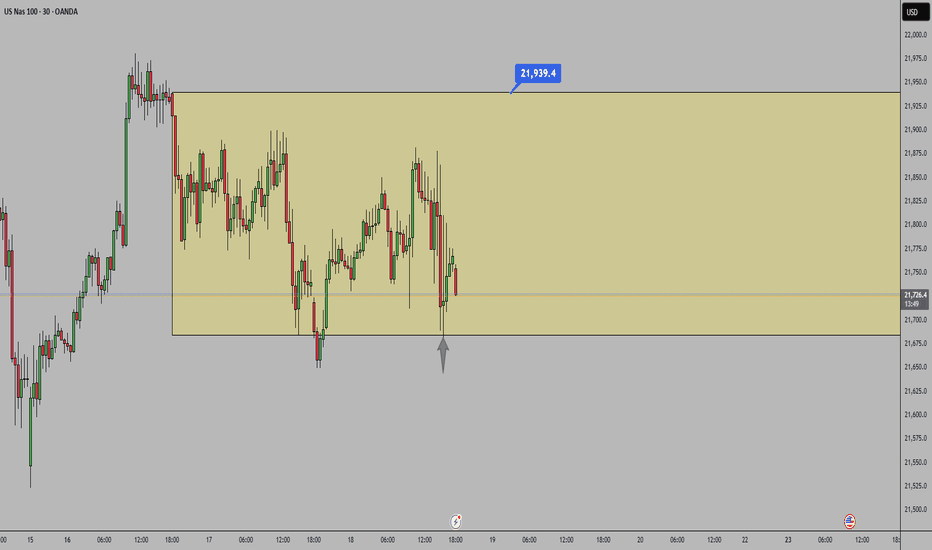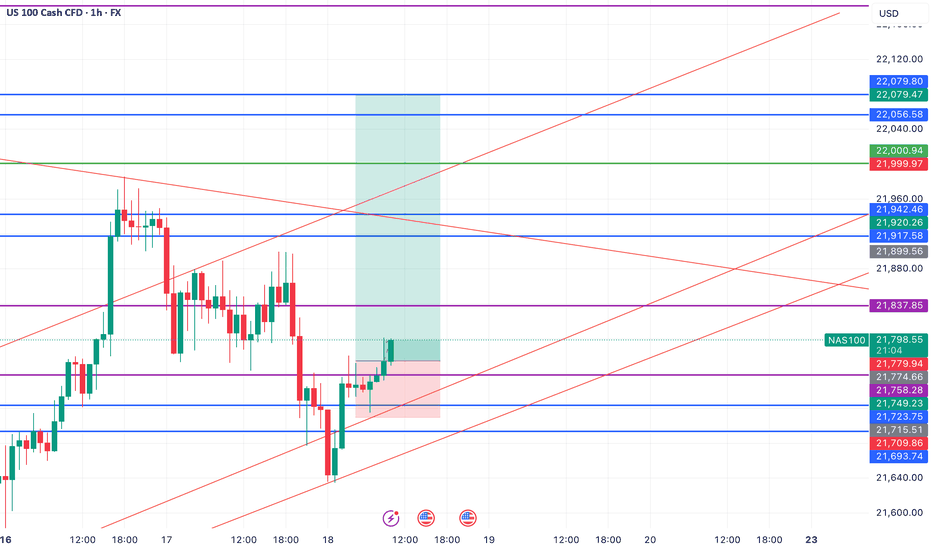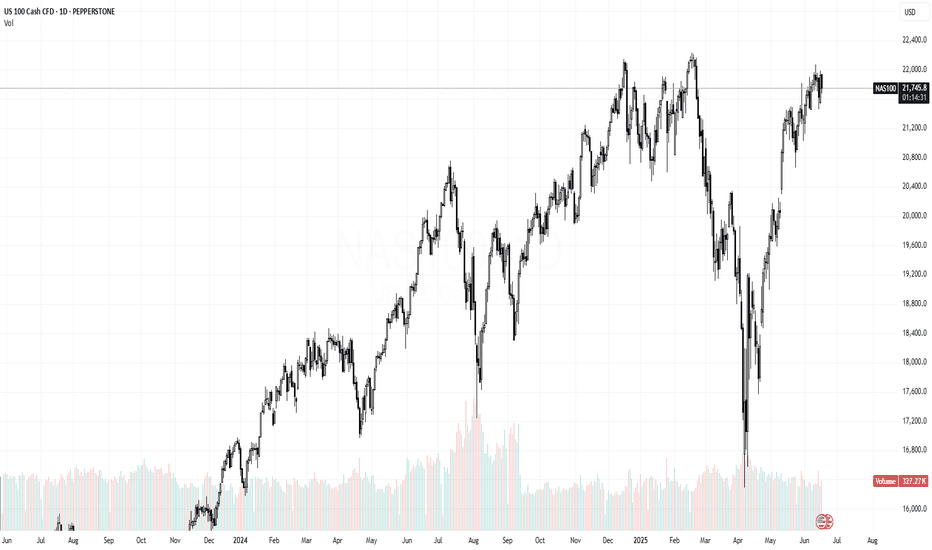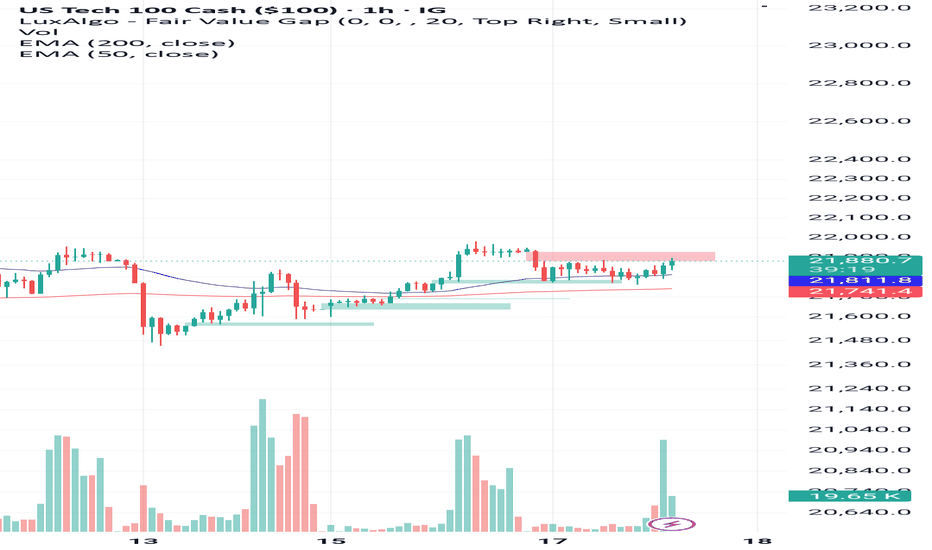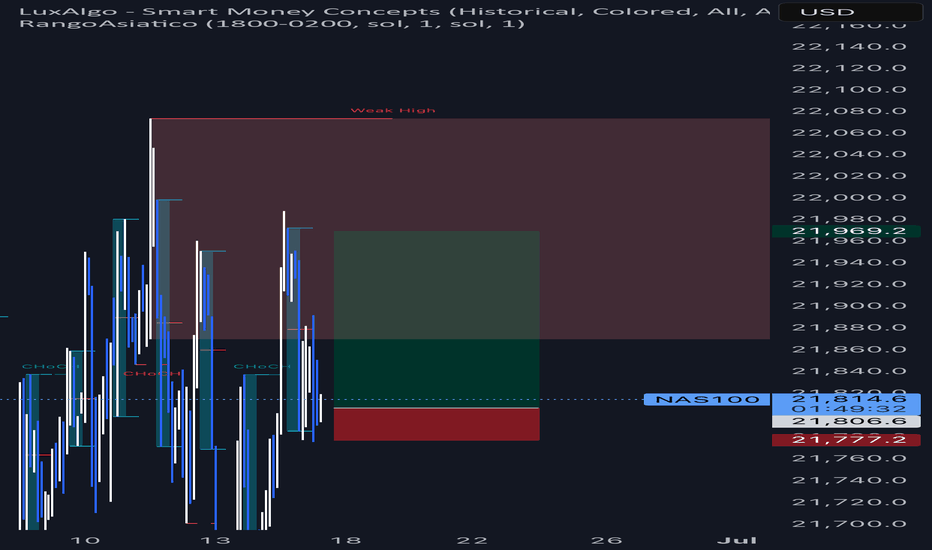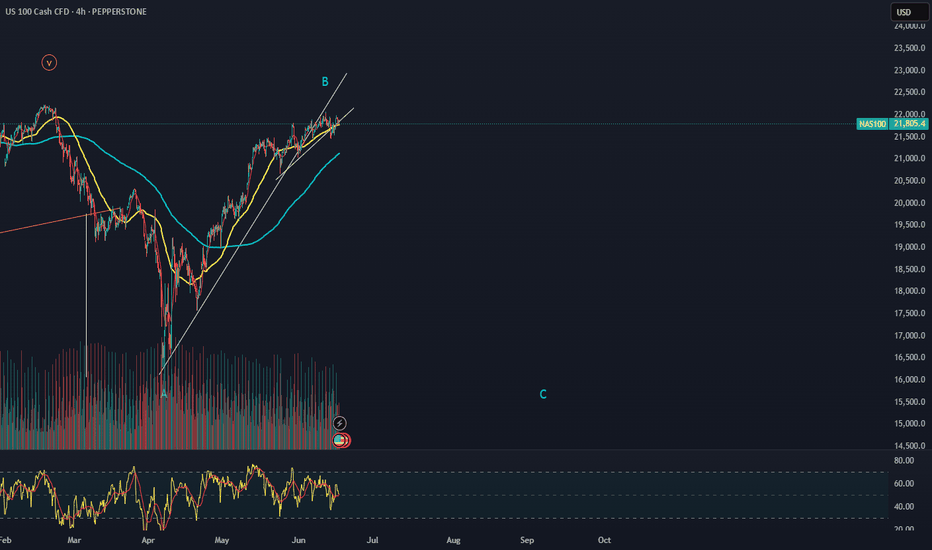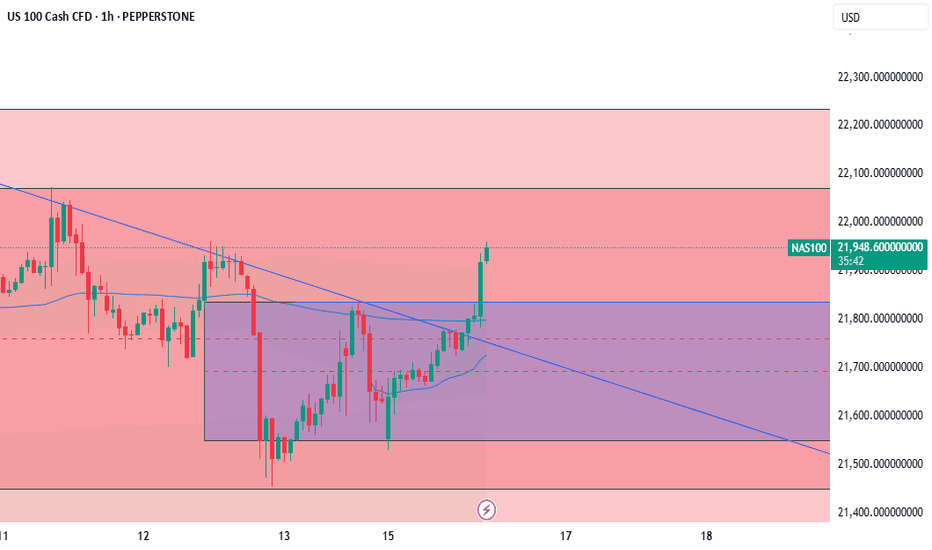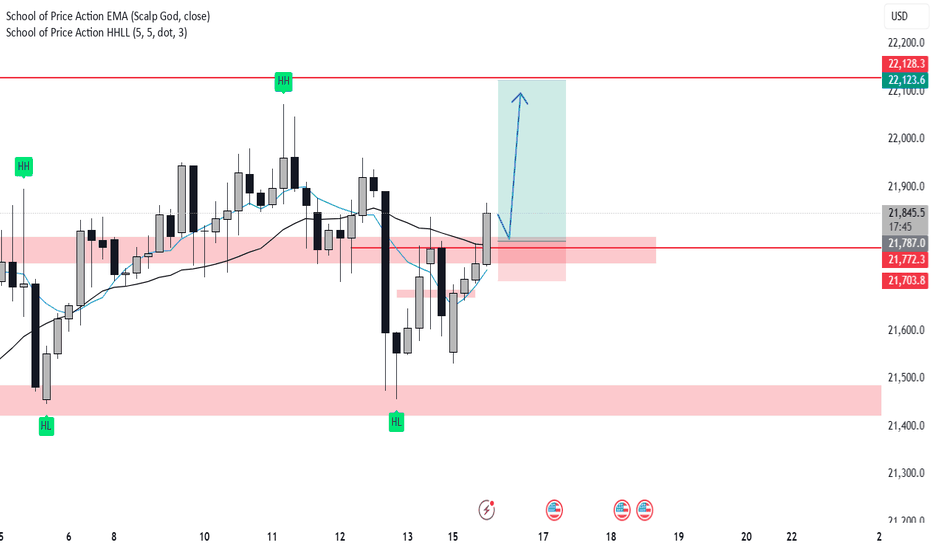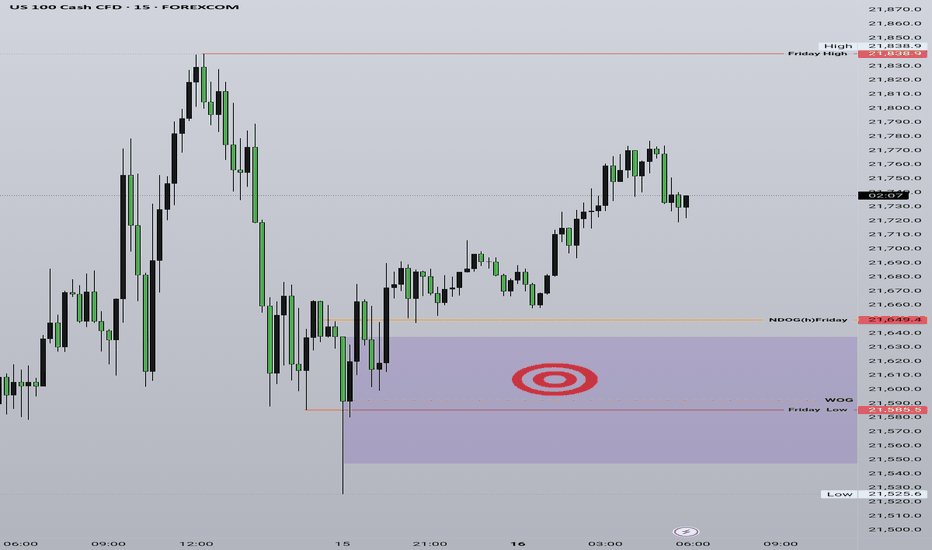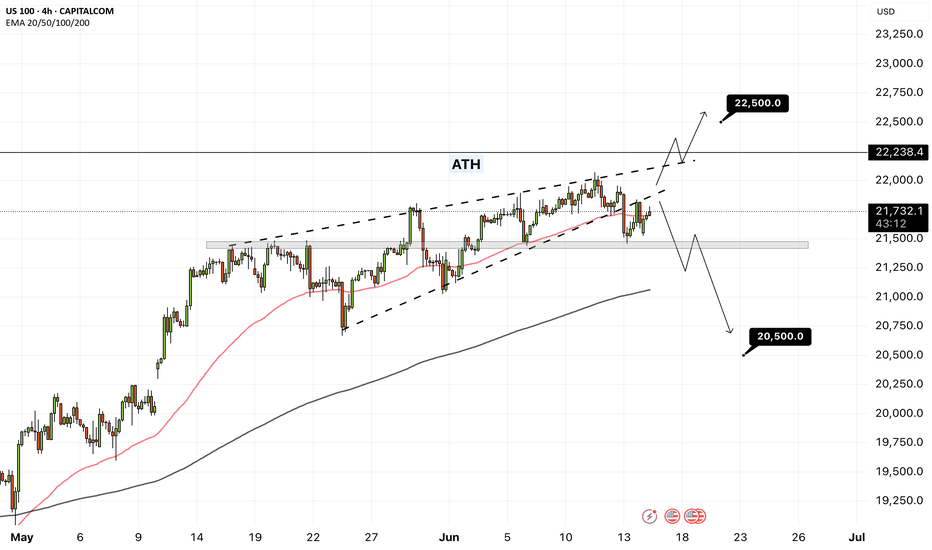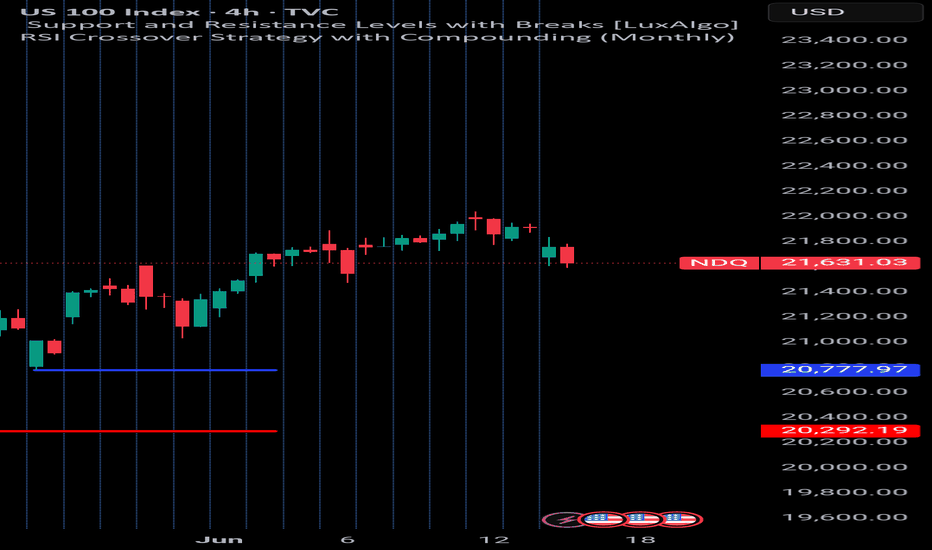NASDAQ Bread and Butter & Turtle Soup Example XIIaight, so im gonna break down a trade i took on nasdaq today using a setup i picked out myself from the ict concepts. just my own flavor of it, ya know
before i knock out at night, i open up the charts real quick — just tryna see if there's any clean liquidity chillin’ nearby. if there aint, i shut it down and catch some solid sleep. but if there is... bingo baby
this basically means i might just wake up rich tomorrow, bro. on the daily, im seeing two strong green days back to back, and right above that boom some equal highs just sitting there, begging to get run. they are even cleaner on the 1h. bias locked in. im waking up tomorrow and hunting longs, simple as that.
i mark up the daily open first thing. if im lookin for longs, i wanna see some turtle soup under the open. if im hunting shorts, i need that setup above the open. thats just how i roll.
if there is a swing low, trend liquidity, or some equal lows carryin over from yesterday, im locked in on those levels for turtle soup. if not, im just chillin, waitin for price to build some fresh liquidity during the day and then snatch it.
in this setup, i got some leftover liquidity from yesterday plus a clean 4h fvg sittin there like a neon sign.
next, i check the time. liquidity grabs usually hit during one of the killzones depends on the pair, but im watchin asia, london, or new york sessions.
then i scope out if there is any news droppin around that time, especially stuff that could move the pair. no point in getting blindsided.
and yeah, i always peep correlated pairs too sometimes they snitch before your chart even says a word.
when all the stars and planets line up just right, that is when I drop down to the 15m and wait for a clean csd to show up. but here is the thing i dont jump in the second i see it. i wanna see price actually leave the liquidity zone.
yeah, it might lower my rr a bit, but the win rate goes way up. It keeps me outta those fake-ass turtle soups that look good at first but just wanna wreck your stop.
once im in the trade, i usually try to close out half the position the same day take profits where the chance of price reversing is damn near zero. then i let the other half ride toward my target liquidity. just lettin it breathe, do its thing.
thats it, peace out
USTEC trade ideas
Pullback before next leg up
NASDAQ’s looking weak short term. We’ve seen multiple rejections from the highs, an M pattern forming on the daily, and RSI divergence creeping in on the daily — momentum is clearly fading. I already took profit around 21980. And a few small swings between the range since 3rd of June.
The rally off the tariff drop was sharp, but it feels mechanical. Bulls look tired here. You can see price is stalling — pushing into the same highs but getting nowhere. Classic signs of distribution.
That said, this isn’t the start of a full-blown bear market. The long-term trend remains bullish. AI investment is still piling into the U.S., tech’s still leading globally, and structurally we haven’t broken down yet. Some weakness is starting to show though.
But short term, I think we see a pullback. The Fed’s still sitting on the fence with rate cuts, which is creating uncertainty. Add that to the current geopolitical tensions, and there’s enough on the table to justify a temporary risk-off move.
If price breaks and closes above 21,860, I’ll reassess and potentially shift back to a bullish bias. Until then, I’m leaning short and letting price action do the talking.
My key downside levels:
TP1: 21,483 — scale out and protect.
TP2: 21,322 — potential bounce from this area.
TP3: 21,145 — structure starts to weaken.
TP4: 20,894 — bears starting to control and a deeper flush, I’ll reassess bias at this level.
SL @ 21850 on my second entry short
Short term: pullback likely.
Big picture: still bullish — but bulls need to reset before any next leg up.
*NAS100| Weekly Breakdown - Structure Is PriceWhew—Nasdaq was a wild one this week, but once you master structure, liquidity, and OBs, the chaos turns into clarity.
Price held my 30M demand zone, even after a sketchy wick-based reaction early on. First long position? Quick scalp to the highs—in and out, no burger 🍔.
Didn’t wait for a full mitigation at first—anticipated the bullish momentum by staying aligned with structure. Later, price came back and mitigated the zone with body closes, confirming the intent for another long setup into next week.
Yes, I hold trades over weekends—because here’s what I’ve figured out:
“Price is structure. Structure is price. Master that, and it flows exactly how it should.”
This week was just another example of that.
Bless Trading!
Who got in?🟢 NAS100 15min – Bottom Sniped to Perfection!
Another textbook bounce called in real-time by the ELFIEDT – X-REVERSION indicator.
✅ The UP signal printed at the exact low
📈 Price launched shortly after with a near vertical reaction
💥 No hesitation. No lag. No repainting.
⸻
🔍 Still watching from the sidelines?
This is what precision looks like when momentum, volatility and structure all align — and we’ve automated that edge into one system.
📌 Just follow the rules:
• Enter on the signal close
• SL below the signal bar
• Let the market do the rest
⸻
🔥 If you’re still hesitating… you might just be watching these trades instead of catching them.
Time to load up the ELFIEDT – X-REVERSION tool and trade with confidence.
NASDAQ - Long now!⚡️ NAS100 15-Min Reversal Signal – Caught the Bottom?
The ELFIEDT – X-REVERSION indicator just printed a clean BUY signal on NAS100 after a strong sell-off into new session lows.
📉 Price had already extended far from structure
📈 RSI momentum began shifting and reversed sharply
✅ Volume spike and RSI reversal confluence added weight to the signal
📍 These types of signals are designed to catch mean reversion moves — especially powerful when price accelerates into extremes and the candle closes with absorption.
🎯 Remember: the signal is plotted on the close of the bar, meaning it doesn’t repaint and allows for real-time decision-making with a clear stop-loss just below the low.
💡 Watch for a potential retrace toward structure or session VWAP.
NASDAQStable bullish bias—large speculators are neither aggressively piling in nor stepping back.
Lack of a sharp position shift suggests the market is in consolidation or mild uptrend rather than a strong breakout.
Watch for fresh breakout above recent highs or shakeouts below support to confirm a shift in direction.
Bias: Slight bullish.
Turn Your Chart – Turn Your ViewCurious about tricking your trading mind?
A lot of traders are constantly searching for new indicators or secret setups. But what if your biggest breakthrough is just a perspective shift away—literally?
This article is about a unique but effective experiment: Rotate your candlestick chart by 90 degrees (horizontal instead of vertical) and see how your perception and analysis change.
Example: ibb.co
No, this isn’t a volume profile – this is the real NAS100 chart, just rotated by 90°!
What do you see now? New patterns? Different price action? Sometimes a fresh angle reveals details you normally overlook and helps break your trading habits.
---
What changes?
1. Patterns suddenly look different
Trends, consolidations, and breakouts appear in a new light:
– Uptrends and downtrends lose their emotional “up feels hard, down feels easy” effect.
– Sideways markets become vertical clusters—your eye spots new structures.
2. Support & resistance become less dominant
Your classic support and resistance zones disappear.
You’re forced to rethink important levels—maybe you’ll notice supply/demand zones you always missed.
3. Emotional neutrality
With a rotated chart, the usually existing “Long is better” bias fades.
You view price action more objectively—and may discover signals you’d otherwise miss.
---
Try it out!
What did you discover by rotating your chart? Comment below or share your thoughts!
Nasdaq EMA and FVG AnalysisThe EMA 50 on the hourly chart at 21,810 has been an area of support. Breaking down blow this level will send the price searching for EMA 200 at 21,740. Above 21,900 there is an FVG from earlier today and breaking through the upper bound at 21,940 will likely send the price upwards beyond yesterday's swing high.
NASDAQ 100 Bullish Breakout Potential: What to Watch NextI'm currently monitoring the NASDAQ 100 (NAS100) very closely. Building on yesterday’s outlook, we've now seen a clear bullish structural shift — price is holding firm above a recent higher high and higher low, suggesting the early stages of a potential trend continuation 📈
Zooming into the 30-minute chart, we can track price action more precisely. I’m watching for a decisive break above the current range high on this timeframe. If we get the break → retest → rejection pattern, this would confirm bullish momentum and provide a long opportunity 🚀
Should this scenario play out, we could also see JPY pairs strengthen to the upside, as a risk-on sentiment flows through the markets 🧭
🔍 This setup is developing — as always, patience and precision are key.
NAS100 live trade execution 10k profit and breakdown Seven fundamentals for the week: Iran-Israel war, Fed to fire up tariff-troubled markets
Premium
When will the Fed cut interest rates? That question competes with the Israel-Iran war and the fate of the tariffs America slaps on its peers. US retail sales and interest rate decisions in Japan and the UK keep things lively as well.
NASDAQ Analysis: Navigating Uncertainty in a Shifting LandscapeThe NASDAQ has been on a rollercoaster ride lately 🎢, reflecting both global macro shifts and sector-specific dynamics. After dipping into bear market territory earlier in the year, the index has rebounded strongly, powered by mega-cap tech and the ongoing AI boom 🤖. However, the mood remains cautious as investors weigh political and economic cross-currents. Note how price action is stalling at the current level.
Fundamentals & Earnings 💼
Earnings Resilience: Q1 2025 earnings for NASDAQ heavyweights were robust, with tech giants posting double-digit growth. Yet, forward guidance is more muted, as companies brace for the impact of higher tariffs and global supply chain adjustments.
Valuations: The recent rally has pushed forward P/E ratios well above long-term averages, making the market more sensitive to any negative surprises 📈.
AI & Innovation: Capital expenditure on AI is set to exceed$300 billion this year, keeping the sector in the spotlight and fueling optimism for long-term growth.
Political & Geopolitical Factors 🌍
Trade Policy: The U.S. and China have agreed to a temporary pause on new tariffs, easing some immediate concerns. However, the average effective tariff rate remains much higher than last year, and uncertainty lingers as legal challenges and further negotiations loom.
Fiscal Policy: U.S. deficit worries are back in focus, with new legislation projected to add trillions to the national debt over the next decade. This has contributed to higher Treasury yields and a weaker dollar 💵.
Global Competition: International equities have outperformed U.S. stocks over the past six months, but history suggests this may be stretched, and a reversal could be on the horizon.
Market Sentiment & Technicals 📊
Volatility: While volatility has eased from its spring highs, sentiment remains fragile. Consumer and business confidence indices are at multi-year lows, even as hard economic data (like jobless claims) remains resilient.
Sector Rotation: Growth and cyclical sectors—especially tech, consumer discretionary, and industrials—have led the rebound, but investors are increasingly selective, favoring companies with strong fundamentals and global reach.
Outlook: The NASDAQ is cautiously optimistic for the second half of 2025. The market is pricing in a couple of Fed rate cuts by year-end, but the path forward depends on inflation trends, trade clarity, and corporate earnings.
Key Takeaways 🚦
The NASDAQ is in recovery mode, but faces headwinds from trade policy, fiscal uncertainty, and stretched valuations.
Political developments—especially around tariffs and fiscal policy—will be key drivers of volatility.
Long-term, the AI and tech innovation wave remains a powerful tailwind, but near-term caution is warranted.
Disclaimer:
This analysis is for informational purposes only and does not constitute investment advice. Markets are volatile and subject to rapid change. Always do your own research and consult a financial advisor before making investment decisions.
NAS100 - Stock market awaits an important week!The index is above the EMA200 and EMA50 on the 4-hour timeframe and is trading in the specified pattern. If it does not rise again above the broken trend line, I expect a correction.
If the index returns above the broken trend line, we can expect a new ATH to be recorded on the Nasdaq. It is better to wait for confirmation on the breakout in order to control further risk.
Last week, U.S. stock markets—particularly the Nasdaq index—experienced significant volatility, driven by a combination of economic and geopolitical factors:
• A reduction in trade tensions due to ongoing U.S.-China negotiations
• The release of inflation indicators
• Heightened geopolitical tensions
According to Politico, as G7 leaders meet in Canada, the escalating conflict between Israel and Iran will top the agenda. Politico reported that leaders of the free world have gathered in the Rocky Mountains to discuss the very real threat of a full-scale war in the Middle East. The initial sessions of the G7 summit will take place in Kananaskis, where the worsening Israel-Iran conflict will be the primary focus. Donald Trump, who in recent days has fueled tensions through social media, is now expected to join discussions aimed at de-escalation.
On the economic front, lower-than-expected inflation in May could encourage the Federal Reserve to cut interest rates sooner than markets had previously anticipated. On Wednesday, the Bureau of Labor Statistics reported that inflation rose 2.4% in May compared to a year earlier. Housing costs were identified as the primary driver of this inflation, while price increases in categories most affected by high tariffs were not as pronounced as economists had expected. So far this year, the Fed has refrained from cutting its benchmark interest rate, citing concerns that tariffs might push consumer prices higher. While the likelihood of a rate cut at this week’s meeting remains low, the latest report could ease some of these worries and accelerate the timeline for potential cuts.
Meanwhile, Bloomberg reported that a growing group of President Trump’s advisers is urging him to consider Besant for the Fed chair position. Jerome Powell’s current term extends until May 2026, and he was originally nominated by Trump in November 2017. Other names reportedly under consideration include Kevin Warsh (considered a favored candidate), Kevin Hassett (head of the White House National Economic Council), Christopher Waller (a current Fed board member), and David Malpass (former World Bank president).
After a week dominated by U.S. inflation data, investor attention in the coming days will shift toward central bank decisions and potential signals regarding the future path of interest rates. The trading week kicks off Monday with the Empire State Manufacturing Index, offering an initial snapshot of the industrial sector in New York. Later that day, the Bank of Japan will announce its first interest rate decision, an event that could shape Asian market trends and the yen’s valuation.
On Tuesday, May’s U.S. retail sales data will be released—a key indicator of consumer strength. Signs of weakness in this report could bolster expectations for rate cuts. Wednesday will be the focal point of the week, as the Federal Reserve announces its policy decision. While markets have already priced in a pause in tightening, investors will scrutinize Jerome Powell’s remarks for clues on the likelihood of rate cuts in the months ahead. Additionally, data on May housing starts and weekly jobless claims will also be released that day.
On Thursday, with U.S. markets closed for Juneteenth, attention will turn to monetary policy decisions from the Swiss National Bank and the Bank of England. Changes in tone or interest rates from these key European central banks could influence currency market volatility. Finally, the week will conclude Friday with the release of the Philadelphia Fed Manufacturing Index—a leading indicator closely watched by traders for insights into the health of the manufacturing sector in the U.S. East.
Smart money NASDAQ analysis
🚦 SMART MONEY SIGNAL – NASDAQ H4
You're on the 4-hour (H4) timeframe.
Price tapped the 200 EMA (white line) — commonly seen as a Smart Money Demand Zone.
Strong bullish candle formed = possible rejection from an institutional level.
RSI at 47 = neutral zone, still room to go higher.
---
📊 Smart Money Interpretation:
🟢 Market Structure:
Liquidity sweep below (stop-loss hunt under 200 EMA).
Bullish rejection candle = clear sign of Smart Money involvement.
🔻 Liquidity Grab:
Price broke the recent low then quickly reversed = manipulation phase complete.
Likely H4 Bullish Order Block formed (area of institutional buying).
---
✅ Entry Signal (Buy Setup)
🔹 Direction: Buy / Long
🔹 Entry Zone (Buy Limit):
🔸 Between 21,650 and 21,680
🔹 Stop Loss:
🔸 Just below the wick = 21,570
🔹 Take Profit Levels:
TP1: 21,900
TP2: 22,000
> Targeting imbalance fill + possible structure break
🔹 Risk/Reward Ratio: 1:2 to 1:3 (solid for Smart Money setups)
---
🔁 Entry Confirmation (Lower Timeframe):
Wait for price to pull back into the H4 Order Block.
Look for M15 or M5 bullish reaction (pin bar or bullish engulfing).
RSI > 50 on M30 or H1 = momentum confirmation
🧠 Pro Tip (Smart Money Style):
Draw the H4 Order Block (last bearish candle before the move up). If price returns to this area and shows a strong bullish reaction — you’ve got a high-probability institutional entry. Talion-promosale
-
